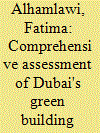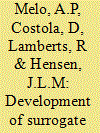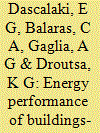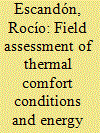|
|
|
Sort Order |
|
|
|
Items / Page
|
|
|
|
|
|
|
| Srl | Item |
| 1 |
ID:
104821


|
|
|
| 2 |
ID:
136246


|
|
|
|
|
| Summary/Abstract |
The UK׳s housing stock generates approximately 27% of the country׳s total annual carbon emissions. In light of the legally binding targets to reduce carbon emissions, new housing is subject to a tightening of regulations governing energy demand and efficiency resulting in a gradual improvement in carbon emissions. The question is how to achieve the deep carbon emission reductions from existing domestic properties, of which 75% will still be in use in 2050. Government has sought to provide incentives to homeowners to improve the energy efficiency of their households, and mandate improvements in socially rented housing using a range of fiscal measures, most recently the ‘Green Deal’. There has however been little consideration of the 18% of UK households who privately rent their home, a tenure that is growing fast. The aim of this research is to investigate the factors that influence private sector landlords when considering energy efficiency improvements to their tenanted homes. The results indicate that government policy has consistently failed to engage private sector landlords in the issue of energy efficiency and thus measures must be taken to understand the motivations of landlords in order to design effective incentives and interventions.
|
|
|
|
|
|
|
|
|
|
|
|
|
|
|
|
| 3 |
ID:
180157


|
|
|
|
|
| Summary/Abstract |
In line with global trends towards energy efficiency, Dubai's Government introduced Al Sa'fat Green Building Rating System (GBRS) to reduce the energy intensity of its building sector. This study presents the first comprehensive evaluation of Al Sa'fat with emphasis on building energy performance, shedding light on its effectiveness, limitations, and techno-economic potential. Following a comparison of Al Sa'fat to international and regional GBRSs, a detailed energy-efficiency analysis is conducted using building performance simulations applied to local residential and commercial building archetypes. The benefits of adopting Al Sa'fat at the urban scale are then estimated using a macro techno-economic analysis. Results confirm the potential of Al Sa'fat in curbing current consumption patterns with energy savings ranging from 22% for hotel buildings to 63% for single-family villas. The anticipated monetary savings from adopting Al Sa'fat in Dubai are equally significant and could exceed USD 100 Billion over the next 25 years. Finally, recommendations are made to overcome critical limitations of Al Sa'fat, including the minimal emphasis on water efficiency measures and limited differentiation between its current certification levels (i.e., bronze, silver, gold, and platinum), which could discourage building owners and developers from pursuing high certification levels.
|
|
|
|
|
|
|
|
|
|
|
|
|
|
|
|
| 4 |
ID:
114298


|
|
|
|
|
| Publication |
2012.
|
| Summary/Abstract |
This paper presents a review undertaken to understand the concept of 'future-proofing' the energy performance of buildings. The long lifecycles of the building stock, the impacts of climate change and the requirements for low carbon development underline the need for long-term thinking from the early design stages. 'Future-proofing' is an emerging research agenda with currently no widely accepted definition amongst scholars and building professionals. In this paper, it refers to design processes that accommodate explicitly full lifecycle perspectives and energy trends and drivers by at least 2050, when selecting energy efficient measures and low carbon technologies. A knowledge map is introduced, which explores the key axes (or attributes) for achieving a 'future-proofed' energy design; namely, coverage of sustainability issues, lifecycle thinking, and accommodating risks and uncertainties that affect the energy consumption. It is concluded that further research is needed so that established building energy assessment methods are refined to better incorporate future-proofing. The study follows an interdisciplinary approach and is targeted at design teams with aspirations to achieve resilient and flexible low-energy buildings over the long-term.
|
|
|
|
|
|
|
|
|
|
|
|
|
|
|
|
| 5 |
ID:
132680


|
|
|
|
|
| Publication |
2014.
|
| Summary/Abstract |
Surrogate models are an important part of building energy labelling programs, but these models still present low accuracy, particularly in cooling-dominated climates. The objective of this study was to evaluate the feasibility of using an artificial neural network (ANN) to improve the accuracy of surrogate models for labelling purposes. An ANN was applied to model the building stock of a city in Brazil, based on the results of extensive simulations using the high-resolution building energy simulation program EnergyPlus. Sensitivity and uncertainty analyses were carried out to evaluate the behaviour of the ANN model, and the variations in the best and worst performance for several typologies were analysed in relation to variations in the input parameters and building characteristics. The results obtained indicate that an ANN can represent the interaction between input and output data for a vast and diverse building stock. Sensitivity analysis showed that no single input parameter can be identified as the main factor responsible for the building energy performance. The uncertainty associated with several parameters plays a major role in assessing building energy performance, together with the facade area and the shell-to-floor ratio. The results of this study may have a profound impact as ANNs could be applied in the future to define regulations in many countries, with positive effects on optimizing the energy consumption.
|
|
|
|
|
|
|
|
|
|
|
|
|
|
|
|
| 6 |
ID:
104811


|
|
|
| 7 |
ID:
113458


|
|
|
|
|
| Publication |
2012.
|
| Summary/Abstract |
Transposition of the European Directive on the energy performance of buildings (EPBD) in Greece was enacted in 2008 by a national law. A follow-up regulation on the energy performance in the building sector-KENAK released in 2010, outlines the overall approach in accordance to European standards and EPBD mandates. All necessary technical specifications and detailed information for the implementation of KENAK are included in four new technical guidelines prepared in 2010, which are supported by an official national software. Issues related to the energy experts are handled by presidential decrees published in 2010; over 5400 temporary energy inspectors are already in place, while permanent accreditation is in progress. Energy performance design study of new buildings for obtaining a building permit is in place since October 2010 and issuing energy performance certificates as of January 2011. This paper presents an overview of the development and current EPBD stage of implementation in Greece, along with a first assessment of the lessons learned and experiences gained.
|
|
|
|
|
|
|
|
|
|
|
|
|
|
|
|
| 8 |
ID:
171388


|
|
|
|
|
| Summary/Abstract |
The strategy of energy efficiency to save energy is deceptively simple: the idea is to use less input for the highest amount of useful output. However, on a practical and conceptual level, efficiency is an ambiguous and problematic concept to implement. Of particular concern is the lack of contextual and qualitative information provided in energy efficiency measurements based on simple ratios. Oversimplification of efficiency measurements can have a detrimental effect on the choice of energy policies. Efficiency measurements are particularly problematic on a macroeconomic scale where a significant amount of meaningful information is lost through the aggregation of data into a simple ratio (economic energy intensity). First, practical examples are presented flagging conceptual problems with energy efficiency indicators, then an alternative accounting method—the end-use matrix—based on the concept of the metabolic pattern of social-ecological systems is illustrated to show the possibility of enriching efficiency indicators by adding qualitative and contextual information across multiple scales and dimensions. This method unpacks and structures salient energy input and output information in a meaningful and transparent way by generating a rich multi-level and multi-dimensional information space.
|
|
|
|
|
|
|
|
|
|
|
|
|
|
|
|
| 9 |
ID:
166374


|
|
|
|
|
| Summary/Abstract |
Much of the social housing stock in southern Europe is obsolete in energy terms, with users who also present very specific socio-economic profiles requiring in-depth study. Proposals for this type of housing stock of current energy retrofitting policies, based on standardized user patterns, will only contribute to increasing the ‘performance gap’ between real and estimated consumption.
|
|
|
|
|
|
|
|
|
|
|
|
|
|
|
|
| 10 |
ID:
126596


|
|
|
|
|
| Publication |
2013.
|
| Summary/Abstract |
The retail trade sector has been identified as a target sector for the development of sectoral reference documents on best environmental management practices under the Eco-Management and Audit Scheme. This paper focuses on the important energy-related needs in retailers' stores such as for food refrigeration and lighting, as well as heating, ventilation and air conditioning of the building. For the definition of best environmental management practices in the European framework, frontrunner retailers have been identified as those retailers integrating energy minimization and saving measures as standard practice systematically across stores. These best performers also integrate a comprehensive monitoring system in the energy management of every store or building belonging to the company, enabling the rapid identification of energy saving opportunities. An integrative approach is needed to define how best practices should be implemented in combination to optimize energy management within stores: building aspects such as insulation of the building envelope or the heating, ventilation and air conditioning system, should be optimized in combination with best options for refrigeration in food retailers. Refrigeration systems are responsible for half of the final energy use in stores and of their carbon footprint. Natural refrigerants, heat recovery from the condensation stage and covering of display cases are measures with high environmental benefits to reduce the impact of refrigeration. Finally, practices for lighting, as optimal lighting strategies, and the integration of renewable energy sources in overall zero energy building concepts can save considerable amounts of fossil energy, reduce the carbon footprint and produce significant cost-savings in the long term.
|
|
|
|
|
|
|
|
|
|
|
|
|
|
|
|
|
|
|
|
|